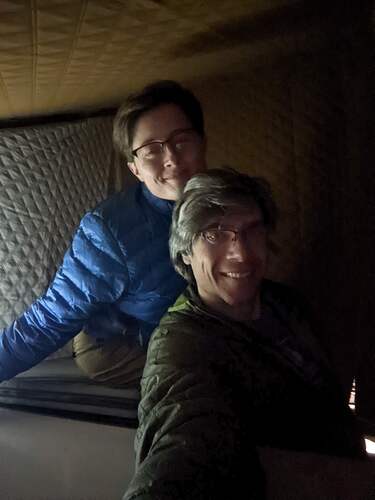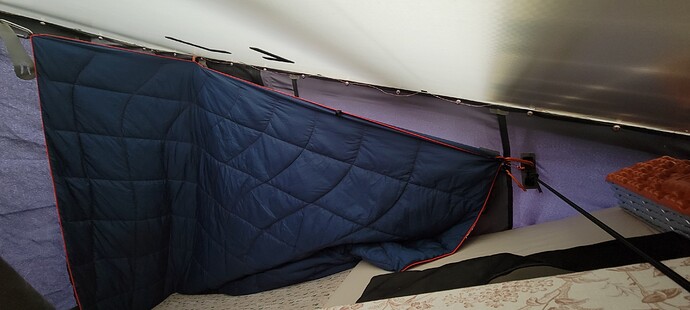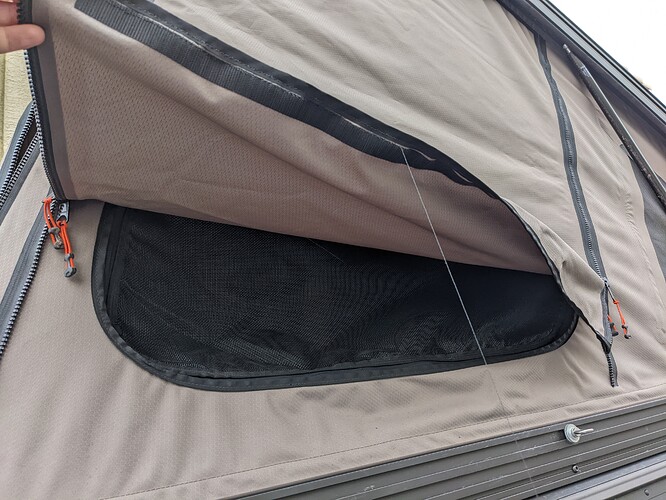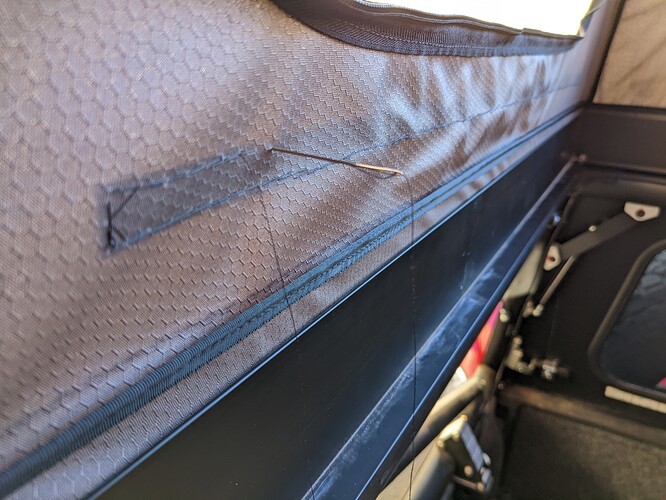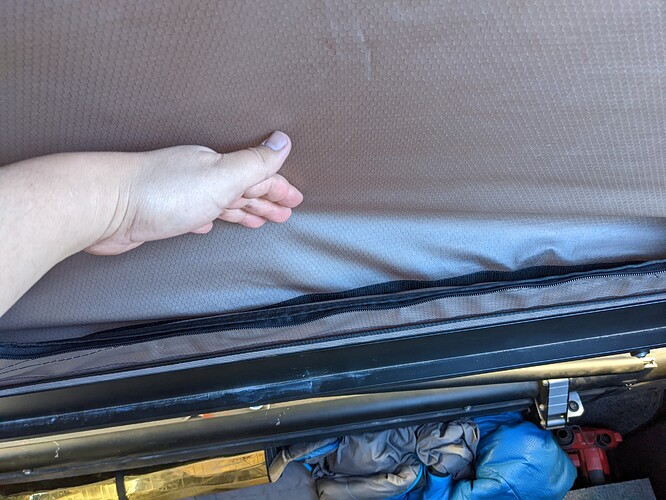I have a quilt from my great great grandma that she sewed 100% by hand. it kind of makes what you are doing like a walk in the park but still very respectable to undertake a project like this WHILE learning how to do it. I tip my hat to you. I can’t wait to see the end product.
Why did you get away from just using this stuff?
https://www.amazon.com/USGI-Industries-Military-Woobie-Blanket/dp/B089ZPP5HY/ref=sr_1_26?crid=1NX7TJR6VHN4E&keywords=insulated%2Bblanket&qid=1641461416&sprefix=insulated%2Bblanket%2Caps%2C140&sr=8-26&th=1 lots of materials on amazon that could be cut to shape!
for sure! I rode crystal mountain on Monday and it was 2 feet of fresh powder. My legs are still cooked. But I have to figure something out. Between my diesel heater and my tent I was warm-ish but the condensation was so bad because I was fighting the cold weather keeping the doors closed up.
You can camp B lot with the RV’s. You obviously pay for it, like $40 or so. But on days like this, it pays to be first in line at the chair lift.
I have been waffling for a long time about attempting a diy version of this. My partner is ridiculously crafty and was willing to help me try and sew something so I took the plunge!
We worked together to put together a pattern that would work. Essentially it is a 3d blanket that my partner lovingly cut and sewed together for me. We installed velcro on the ceiling of the camper and sewed it on to the blanket. The blanket essentially just drapes down the sides and back of the tent. It feels really cozy in there!
I bought these blankets as material for this project. They are very cheap and seem quite waterproof. The waterproofing is a double edged sward. On one hand it needs to be water resistant given that it will be in contact with the tent and it will definitely have some condensation form on the inside of it. On the other you want water vapor to be able to leave the tent. I will definitely need to do a good job venting this camper given the lack of permeability, but at least it is controllable now. The insulation is relatively thin but I think it will be quite helpful in holding in the heat on cold Canadian nights.
Yes, I can close the tent with these in place.
This is far from a perfect solution but it was cheap and relatively straightforward. I will likely upgrade to whatever @WrinkledPants comes up with but I needed something this winter!
Awesome. Seems like a good set up. Velcro makes sense. Do you have any more pictures you can share? How many blankets at what size did it take?
I will take some more pictures when I put it back up and share them here.
I used
2x 52x82
1 82x82
The 82x82 made both sides and the narrower blankets made the roof and the back door.
I have a standard size camper, this would not be enough fabric for an XL.
We had very little waste which is great, but it meant that we did need to do some piecing scraps together on the sides. A 102x82 in stead of the 82x82 would require fewer seams.
Here’s my simple but not so cheap version of insulating my tent for this winter. I clipped in two of my Rumpl blankets to the tent along the space between the tent snaps. It created a very nice air gap between the tent and just enough space for still allowing to manage moisture with the windows.
Not cheap is right, but I have had them for other purposes. Yes, they are still full blankets with the rest hanging. I have no intentions of cutting them to fit, but they are proving to have many uses for me!
While not insulation per se, I mentioned that one of my biggest complaints with the GFC is the drafty side doors. I took the leap and finished sewing on some 3/4" Velcro onto the bottom of one side door. No more drafting under the flap. It sure as hell ain’t pretty, but she works. And holy fk, hand sewing through the Velcro backing AND ripstop is a nightmare. Took me probably 4 hours to sew 120" of stitch for those two 30" strips. My hands and fingers are smoked. And that was only one door. I got faster as I went on, but lots of tangles, broken thread and even broke a needle. Also, use sew-on Velcro. I made the mistake of trying and succeeding with stick on Velcro I had laying around, but talk about gummy needle and thread. That was terrible. The sew on was much less of a struggle, but still rough by hand.
For the other two, I’m probably gonna just pull the flaps out, close the top and put the sewing machine on the roof. I was basically done when I figured that out, and the first flap used adhesive velcro. You don’t want that gum on the needle. Still would have to hand sew the bottom tent side though, but at least I’ll save ~4 hours on those two other flaps. 
I’ll have to grab some basting tape. That’s a great idea. Trying to hold up a 30" long strip of velcro and sew it onto the side of the tent was…a challenge. 
my hands are numb from just thinking about sewing that. probably just need a couple smaller strips not the whole length to hold it closed
I had a very bad time with side draft on my last trip. Propex was pumping out a nice 70 degrees downstairs but it was 28 degrees upstairs, with one square removed and a fan blowing upwards.
I’m going through this trouble, I didn’t wanna do spots and regret not doing the whole strip.
Also worth noting, that Velcro helped to keep the flap tucked out of the way when I was closing the roof. I usually undo the zippers about 6-8" so the flap usually wants to creep out, and I end up flipping/tucking it while closing up. Just a lil positive side effect. 
Here’s an update on our tent insulation project:
Do you have any venting flaps or something so that venting is still a thing. My trip to Colorado got canceled so I couldn’t come check it out but I do know that having a vent in the upper corners would be really helpful to keep the moisture down still…
Hey Scott! We have paired materials that, by their design, can move moisture away from the tent interior. I borrowed a buddy heater earlier this week and ran it for just over two hours with the tent closed up completely. Needless to say, even though it was in the high teens F. outside it was quite toasty inside and there was no discernible moisture on the interior fabric panel of the insulation kit.
My preference is to use a diesel heater and vent the tent in a couple of places. I think with more experimentation I’ll figure out how much to vent and which windows/doors work best to leave cracked open a bit.
Awesome. anytime you need a beta tester let me know… though sometimes life gets in the way of plans to get out of state. I am currently finishing up a tent insulation project myself that has vents in the upper corner so I can use the bottle and zipper method for venting (very non professional but need something to get my wife to go with me on a few more trips coming soon).

